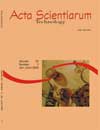Composting as thermal source of energy for heating the water in the aquaculture
DOI:
https://doi.org/10.4025/actascitechnol.v27i2.1488Keywords:
temperatura, crescimento, reproduçãoAbstract
The objective of this work is to use the composting as thermal energy source in the maintenance of aquatic organisms. The area of Toledo possesses annual medium temperature of the air of 20.5ºC and average in the hottest quarter of 27ºC and in the more cold of 16.5ºC. The experimental material consisted of boxes of water, pipes of aluminum, hay of grassy, manure of birds and swine, aquarium compressors, hoses and pipes, porous stones, fish lingers, and thermometer. The temperatures of the air, the composition, and the water without heating were monitored. The medium temperatures obtained were 20.9ºC and 31.1ºC for the air and the composition, respectively. The temperature averages of the water with heating and without heating were 22.0ºC and 20.0ºC. The weight difference among the fish lingers was 24.0%. The conclusion is that the composting can be a thermal source of energy in the aquacultureDownloads
Download data is not yet available.
Downloads
Published
2008-03-27
How to Cite
Hermes, C. A., Souza, S. N. M. de, Feiden, A., Souza, J. de, Bard, J., Scheffer, L., & Engelmann, L. (2008). Composting as thermal source of energy for heating the water in the aquaculture. Acta Scientiarum. Technology, 27(2), 197–205. https://doi.org/10.4025/actascitechnol.v27i2.1488
Issue
Section
Fishery Engineering
License
DECLARATION OF ORIGINALITY AND COPYRIGHTS
I Declare that current article is original and has not been submitted for publication, in part or in whole, to any other national or international journal.
The copyrights belong exclusively to the authors. Published content is licensed under Creative Commons Attribution 4.0 (CC BY 4.0) guidelines, which allows sharing (copy and distribution of the material in any medium or format) and adaptation (remix, transform, and build upon the material) for any purpose, even commercially, under the terms of attribution.
Read this link for further information on how to use CC BY 4.0 properly.











8.png)




